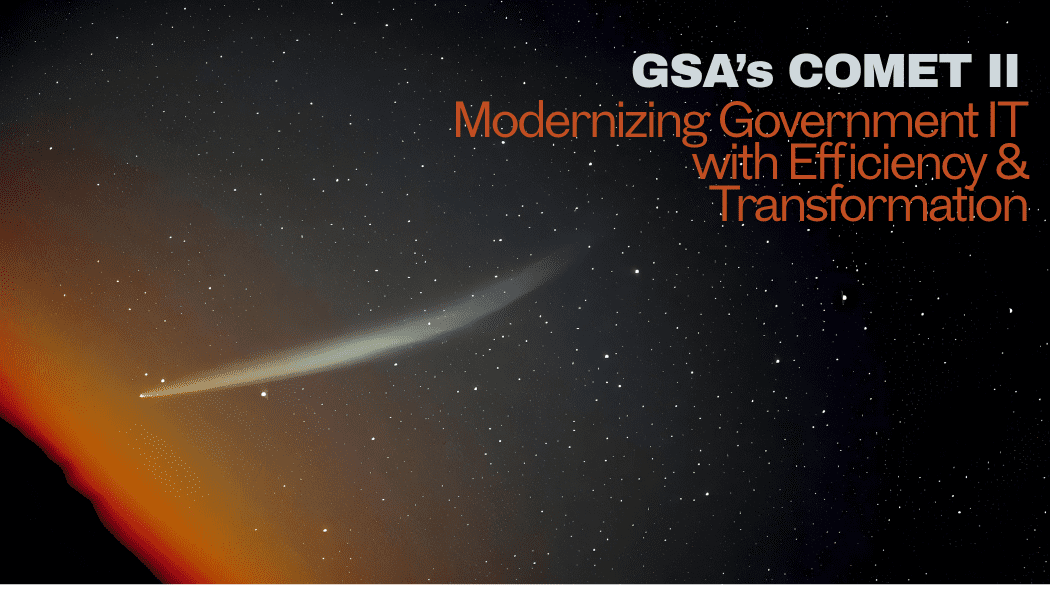GSA’s COMET (CIO Modernization and Enterprise Transformation) program is a multiple-award Blanket Purchase Agreement (BPA) focused on IT modernization, transformation, and operations/maintenance for the General Services Administration (GSA). The original COMET program began in 2019 with the goal of modernizing GSA’s legacy systems and implementing cloud-smart strategies. With its awarded 21+ task orders totaling over $900 million COMET has enabled initiatives like updating GSAFleet.gov, the Personal Property Management System, Supply Chain Management, and SAM.gov. With awards to both large and small businesses. The original COMET program has helped GSA implement zero trust architecture and refine cloud migration processes.
Follow-on Program
COMET II is a follow-on contract scheduled to be released sometime late this calendar year or very early next year. The solicitation is expected to call for a $1 billion IDIQ with an unknown number of awards but will most likely have a significant small business set-aside component, (the current contract has 21 awards). It’s expected to have a 5-year base with all of the work being performed under NAICS 541511, Custom Computer Programming Services with a small business Size Standard of $34 million in annual receipts.
COMET II is expected to have two major areas of emphasis:
- Transformation:
- Establish a unified vision and approach aligned with the FAS Business Architecture and GSA Enterprise Architecture.
- Implement genuine digital transformation using cloud-native, open-source, and emerging technologies to enable business capabilities that support the FAS mission, rather than simply re-platforming existing siloed applications.
- Strike a balance between rapid transformation and minimizing program risk.
- Enhance GSA FAS competitiveness through an innovative and efficient digital acquisition platform
- Efficiency:
- Accelerate transformation by leveraging innovative tools, techniques, and technologies to achieve faster Operations & Maintenance (O&M) and Infrastructure savings.
- Develop a flexible, resilient, and loosely coupled architecture based on common services to reduce redundancies and risks in development and O&M, ultimately lowering costs.
- Implement quantitative Service Level Agreements (SLAs) to measure and incentivize innovation, efficiency, and velocity improvements.
This approach intends to emphasize a holistic transformation strategy that goes beyond simple technology upgrades, focusing on leveraging modern technologies and methodologies to drive meaningful change and operational efficiencies within the organization.
COMET II Requirements
The COMET II solicitation can be expected to have a much different look and feel from the previous program with GSA’s move to a more evidence-based approach ala OASIS+, Polaris, and the current Alliant 3 efforts. Under that assumption you can expect the following:
- A somewhat expansive self-scoring worksheet providing for the slotting of relevant projects into a matrix with associated scoring. This will most likely include certifications such as approved accounting/purchasing/estimation systems, ISO/CMMI, and facility clearances.
- Some substantial amount of documentation regarding your relevant projects including Statements of Work/Performance Work Statements, FPDS=NG reports perhaps requiring signature by the Contracting Officer, and potentially a write-up of the work performed. There may be a breakout for projects fitting the transformation theme versus those more tightly tied to efficiency.
- There may be a requirement for a management write-up of some type, and I think you can anticipate that it would be 25 pages or less.
- Past performance will most likely require CPARS for the submitted work. If CPARS are not available, expect to have Past Performance Questionnaires submitted by your Contracting Officers (CO).
- Pricing by labor categories and there could be a sample task order (though unlikely, given GSA’s recent efforts).
- Unlike OASIS+, expect a pre-determined number of points being required to win a contract.
What Do I Need to Do Now to Win:
Several things come to mind:
- Start to identify your proposal team specifically your Proposal Manager and your Coordinator. You’ll probably need one or two experienced Technical Writers. And potentially an editor. I would anticipate this will require limited graphics support.
- Start the process of identifying your potential progams with an eye toward fitting them into one or both of the categories of transformation and efficiency.
- Begin the process of validating your FPDS-NG data and apprising your Contracting Officers that you may be coming to them for review and signatures. Also, check to make sure that all CPARS are current, and, again, collaborate with your COs if any revisions and scheduled reports are completed.
Keys to Winning COMET II
Organization will be key to this effort, particularly given GSA’s history with evidence-based responses. These are very labor intensive and seem to have a million details. Get your organization in place early; they can start collecting and cataloging the data, and begin the necessary prep work.
How can OCI Assist
With nearly 40 years in the proposal business, OCI has a variety of consultants that can assist in your efforts. Whether you need a single Proposal Manager or Coordinator, one or more Technical Writers, or a whole team, we can provide the quality, experienced personnel you need to WIN!
COMET Experience
We have a limited number of consultants with COMET experience. To ensure you get one of these, you should contact us now.







Leave A Comment